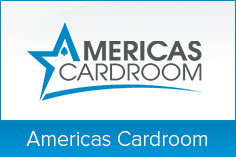Omaha Strategy

It's all the rage among professional players nowadays, but what exactly is Pot Limit Omaha (PLO)?
The main difference between Hold'em and Omaha is that Omaha is played with four hole cards and, importantly, every player MUST use two of these when making a hand
For example, if there were four clubs on the board and a player had one club in their hand they would not have a flush in PLO (they would in Hold'em, however). In this situation, the player would need to have two clubs in their four hole cards in order to make a flush.
This difference may seem small, but it's one that regularly catches players out and often leads to issues when implementing a solid Omaha strategy. Although many tenets of solid Hold'em play are applicable in the PLO world, the addition of two extra hole cards and the "must use two" rule means slight alterations have to be made if you want to be successful.
Arguably the most significant way in which these conditions affect Omaha strategy is variance. PLO is a more volatile game than Hold'em and because the structure is Pot Limit, it means you're forced to play more pots post-flop.
Making pairs, straights and flushes is a lot easier in a game of PLO and for this reason you should always aim to play the strongest starting hands possible and fold anything that's not close to the nuts post-flop.
Good Omaha Starting Hands
While not definitive, here's a good list of starting hands you should print out and keep with you when you first play PLO online:
1. A-A-K-K
2. A-A-Q-Q
3. A-A-J-J
4. A-A-10-10
5. A-A-9-9
6. A-A-x-x
7. J-10-9-8
8. K-K-Q-Q
9. K-K-J-J
Pre-Flop Omaha Strategy in Action
Maintaining a solid starting hand strategy is crucial in PLO, but once you've chosen a suitable hand to play the next thing you need to do is play it as aggressively as possible.
In contrast to a conservative post-flop strategy, your approach to playing pre-flop should be confident. The reason for this is that you want to put as many chips as possible in the middle when your hand is strong and limit your risk when things are against you.
Example 1
The following example should help to illustrate this idea and give you a better insight into playing Pot Limit Omaha pre-flop:
-
You raise 550 with Kd Ks 4h 5s
-
Villain 1 folds
-
Villain 2 calls 450
-
Villain 3 calls 475
-
Villain 4 folds
-
Flop: 6d 3c 10d
-
Villain 2 checks
-
You check
-
Villain 3 bets 550
-
Villain 2 folds
-
You call 550
-
Turn: 6d 3d 10d 10h
-
You check
-
Villain 3 checks
-
The River: 6d 3d 10d 10h 3s
-
You bet 700
-
Villain 3 calls
Result:
Villain 3 shows Jd Js 4h 9s for two pair
You win the pot with Kd Ks 4h 5s two pair
Analysis

In keeping with the idea of strong pre-flop play and conservative post-flop play the hero in this hand raised it up with Kd Ks 4h 5s. Although not the strongest PLO hand possible, a pair of kings and connected 4 and 5 are more than enough to raise with pre-flop.
On the flop an over-pair and straight draw was enough for you to continue, but because of the flush draw it was important not to over-commit too many chips because novice players will generally call with any weak flush
In this instance, a call on the flop was best but after dodging a flush the possibility of trip tens became apparent on the turn. For this reason it no longer became a good idea to be aggressive and once again it was wiser to take a conservative approach.
Finally, the river was a blank three and in this spot it's very likely that, given the previous action on the turn, your hand is good. In this spot there are no more cards to come and it's another relatively strong position for you. Sticking with our strategy, it's best to bet again.
Best Omaha Strategy For Post-Flop Play

One of the best post-flop strategies in any PLO game is to play conservatively, simply because many low-stakes players will rarely fold, even if their hand is well below par.
While this style has its dangers, namely being outdrawn, it does allow you to preserve more of your chips in spots where semi-bluffing won't be effective.
Combining this approach with an aggressive pre-flop strategy will make you a player that's at once threatening and canny enough to survive in a game where strong hands can get outdrawn in the blink of an eye.
Hunting the Fish
The final thing you need to add to your Omaha skill set is table selection. Fortunately, unlike Texas Hold'em, Omaha grinders aren't as skilled in the online arena.
Of course, that doesn't mean all PLO players are weak, but it does mean that the average skill level is a lot lower than it is in Hold'em.
However, that doesn't mean you can simply ante-up at any table and hope to make a profit. Table selection, more over site selection, is also an important Omaha strategy you need to master. Our top tip for finding a beatable table is to look at the stats of the table (you'll see the stats listed in the cash game lobby).
Low pre-flop raise (PRF) stats, combined with a large number of players joining the action, is usually indicative of a weak table. So, any time you see PFR stats of 20 percent or lower and more than 50 percent of players taking to the flop, you should get ready to ante-up and make some money.
Ultimately, being successful in PLO requires a combination of passivity and aggression at the right times. While it's good to up the ante when you're strong, it's equally wise to take your foot off the gas when the board is against you. Once you can find the right balance between these two styles you'll find your profits increasing dramatically.
Top Tip: Take it Slow
Pot Limit Omaha isn't an easy game to master which is why we suggest you take things slowly. Don't be afraid to fold a lot of hands pre-flop and enter the pot only when you're strong.
Doing this will limit your losses in the early stages of your development, but also allow you to make the most money possible from a relatively limited skill set.
Staying patient and thinking about all your possible drawing hands is key to making money. And remember not to jump into games that are out of your comfort level; it's the fastest way to go broke.




